List of Authors
>>About this blog
Recent blog post
|
[kimitaku]
July 31, 2014 17:00
The first time is information on the west side of Harumi-dori St. in Harumi district.
Transportation is Kachidoki Station on the Oedo Line.
By bus, get off at "Kachidoki Station", head toward Harumi, and follow the west side of Reimei Bridge toward Harumi.
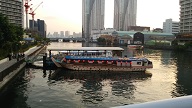
When you cross the Reimei Bridge, you will see the morning tide canal boat landing on the right.
There are many boats coming and going in the afternoon, and at night the lights of ships such as Japanese lantern are exceptional.
Customers wearing yukata on both the houseboat and the cool-down boat are also on board.
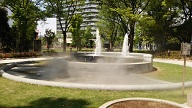
Cross the bridge, on the right is the newly renovated Reimeibashi Park.
Instead of a fountain, a fog fountain ...? It will heal the visitors who come. I feel good in summer.
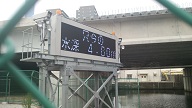
Go out of the park and go along the right river. When you go down Asashio Water Park, you'll get a sea sign.
Looking at the numbers.
The bottom of the river is quite deep.
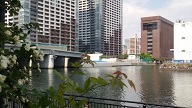
In front of Tokyo Towers, Ring Route 2 toward Shimbashi is under construction.
Head to Harumi Wharf and go through the overpass Route 2. Around this time, the appearance has changed rapidly over time, such as the construction of a high-rise building related to the Ring Route 2.
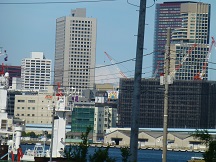 Let's go through Plaza Harumi and look at Tokyo Bay. This is a spot where you can see Mount Fuji while walking. Let's go through Plaza Harumi and look at Tokyo Bay. This is a spot where you can see Mount Fuji while walking.
Early in the morning, when the atmosphere is stable, the male figure is.
However, this "Mot Mount Fuji" may be full of this year.
A high-rise building is under construction in the direction of Shibaura. "Mount Fuji" will soon be over the building. I'm sorry.
At the end of the harbor fire department is a spot.
Next time, from Harumi Wharf.
[Hidekun]
July 31, 2014 14:00
This time, I would like to introduce the jogging course in Chuo-ku.
As soon as possible, what is the ideal jogging course?
I think there are some things such as no traffic lights, no stairs, good scenery, and a public bath nearby.
When I searched for a place that satisfies such conditions in Chuo-ku, I think that Sumida River Terrace is the best.
Among them, the recommended section is about 2 km one way from the north side of Eitai Bridge to the south side of Ryogoku Bridge.
This section has few ups and downs, and you can run from the start while watching the Tokyo Sky Tree.
In addition, there are many ships running on the Sumida River, so if you are lucky enough to find a ship that fits your own pace, you can replace it with a pacemaker.
After jogging, why not sweat at the Ningyocho public bath "World Yu" and then drink a light cup in the neighborhood of Ningyocho, which is crowded with famous shops?
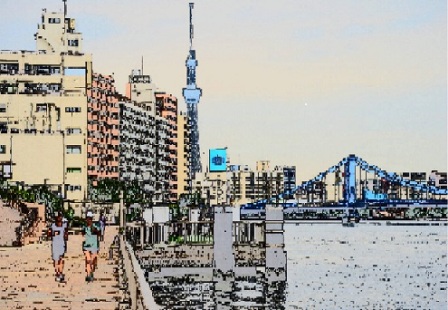
[Yotaro]
July 31, 2014 09:00
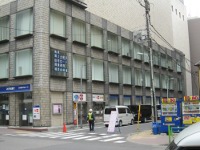 "Tsuyu no Satosaki" is the title of a novel that reminds me of this time. The author is Kafu Nagai (1879-1959). Kafu says, "The title of the novel is too elaborate, it doesn't matter if it's too elaborate," but it's exactly a wonderful title. (Masashi Sada has a song with the same name, but the title of this novel may have been in my head.) "Tsuyu no Satosaki" is the title of a novel that reminds me of this time. The author is Kafu Nagai (1879-1959). Kafu says, "The title of the novel is too elaborate, it doesn't matter if it's too elaborate," but it's exactly a wonderful title. (Masashi Sada has a song with the same name, but the title of this novel may have been in my head.)
In 1959, Kafu celebrated at his home in Ichikawa, and this year 55 years, this year's 55 years, the novel "Sumida River", "Sumitomo 1959" in the book "Hiyowa Geta" diary "Syotei Nijo", etc. In recent years, the number of female readers who were previously said to be empty has increased, and this is the end of Dokei.
By the way, speaking of Kafu's homes, "Shikikan" inbei-cho, Azabu-shi, "Shokutei" in Ushigome Yochomachi (behind the prison station"), and the birthplace of Koishikawa Kintomi-cho ("Fox") are famous. However, we seem to have a short period of time in Chuo-ku, but it seems to have a lot of Tsukiji neighborhood.
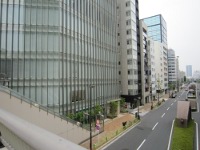 In May 1915 (1915), Kafu moved from his late father's house in Yochomachi to a rented house at 1-6 Tsukiji, Kyobashi-ku (currently 2-7 Tsukiji). The second floor was 10 tatami mats and 6 tatami mats, the lower floor was 8 tatami mats, 6 tatami mats, and 3 tatami mats. The rent was 26 yen, and there was a residence of Kiyoharu's teacher Umekichi next to the back. In September of the same year, he moved to her in 9-chome, Sojuro-cho (currently Ginza 7-5) to live again with the divorced geisha Yaeji (later Seiju Fujikage). In May 1915 (1915), Kafu moved from his late father's house in Yochomachi to a rented house at 1-6 Tsukiji, Kyobashi-ku (currently 2-7 Tsukiji). The second floor was 10 tatami mats and 6 tatami mats, the lower floor was 8 tatami mats, 6 tatami mats, and 3 tatami mats. The rent was 26 yen, and there was a residence of Kiyoharu's teacher Umekichi next to the back. In September of the same year, he moved to her in 9-chome, Sojuro-cho (currently Ginza 7-5) to live again with the divorced geisha Yaeji (later Seiju Fujikage).
Next, in September 1917 (1917), he moved from a house in Yochomachi to an alley in Kibikicho 9-chome (currently Ginza 7-chome 15-18) near Izumo Bridge and a second-floor house with lattice doors. It is named "Muyoan". The reason for the rented house was that Dr. Oishi of Nakasu Hospital was easy to receive a home call in case of emergency. At this time, "Shokutei Nijo" began, and it is written until the day before death.
At the end of 1918 (1918), Kafu sold the old house in Yochomachi for a total of 26,264.22 yen, and sold a house behind the alley at Tsukiji 2-300 Tsukiji behind Tsukiji Honganji (currently 3-chome 10, 11) for 2,500 yen and move. It's almost a year and a half. In May 1920,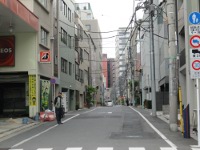 a new house "Shikikan" was completed on a leased land on a cliff at 1-6,beicho, Azabu-shi, and will leave Tsukiji. a new house "Shikikan" was completed on a leased land on a cliff at 1-6,beicho, Azabu-shi, and will leave Tsukiji.
Kafu loved the taste and emotion of the downtown area, but when I actually lived, I couldn't withstand the human relationships that were too close, the busyness behind the alley, and the badtaro of the noisy town, and returned to `` a mountainside with lots of trees '' I went.
It is extremely difficult to remember the appearance of the time when you heard the sound of the shamisen, a bustling city as you know, but once by all means for Kafu fans, Kabuki sightseeing, Tsukiji gourmet walk, etc. Please try. The annual Tsukiji Honganji Noryo Bon Dance Festival will be held until August 2nd. Here, there is a famous store in Tsukiji, which is said to be "the best Bon Odori in Japan". It's a good idea to take a walk in the neighborhood where the great walker Kafu lived before seeing it.
[On the photo] The area around 1-6 Tsukiji 1-chome
[In the photo] From the ruins of Izumo Bridge, you can see the old Kibikicho 9-chome
[Lower photo] Former 2-30 Tsukiji 2-chome
[Koedo Itabashi]
July 30, 2014 14:00
This kind of person came to the correspondent of the tourist association.
I felt very proud and nostalgic.
Lecturer of "town walk leader training (hospitality course)" is Masanori Shikita, who plays a concierge at Nihonbashi Takashimaya. 67 years old.
A good-looking uncle wrapped with a soft expression.
I was comfortably drawn into the story by the voice that passed well and the rich expression.
The "Edo Town Walking Leader Training" is a workshop for correspondents, cultural property supporters, sightseeing ambassadors, Miss Chuo, etc. in Chuo-ku.
This year, we will conduct two lectures on the role and knowledge of the leader, travel laws and regulations, and set up a model course and conduct on-the-job training to actually lead, and on July 29 as the fourth workshop "Hospitality Lecture "was held.
I was in Tokyo in 2020, and I participated because I wanted to do what I could do at that time.
Mr. Shikita talked about Takashimaya's management philosophy, customer satisfaction, and as a concierge pursuing "best hospitality" starting with the history of the department store industry and situation analysis.
These contents may be something that can be obtained from many business books.
However, the shorter the time I felt, each one came into my body honestly.
The many episodes that I had been working on were fascinating.
"To make a lot of friends who have information. It will be a source of information."
"I'm close to the customer and look for an answer that's close to me."
"Preparing the customer with an optional answer."
I felt that the charm of Shikita Concierge was that they noticed the situation, acted quickly, and enjoyed creating smiles.
Speaking of which, I have erased the on-the-job training of the third workshop from my memory for a while.
I thought I was doing a simulation that guided me at key points while taking the lead with a flag, but I made a mistake in one corner to bend and almost crossed a road without a pedestrian crossing, The rows of lead fell apart, spread all the way, and there were no appropriate words to give instructions, so I forgot that this training had not been done and forgot to drink.
"Would you like to acknowledge the regret that your power did not reach and make use of it next?"
I felt like I had received such encouragement from Mr. Shikita.
By the way, I wrote earlier, "I felt nostalgic."
When I was a student, I worked part-time at Takashimaya during my mid-year and year-end gifts, and maybe I met him at that time.
[Apricot peony]
July 30, 2014 09:00
It is very rare in St. Luke's International Hospital, but there are two galleries in the sense of therapy to patients proposed by Dr. Shigeaki Hinohara.
In addition to paintings such as pastel paintings, there are a number of works that heal people's hearts, such as handmade accessories and handicrafts such as accessories.
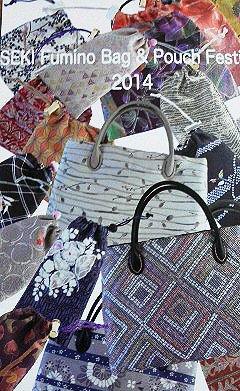 The first gallery next to the cafeteria on the first floor will be held from August 4 (Mon) to 9 (Sat). The first gallery next to the cafeteria on the first floor will be held from August 4 (Mon) to 9 (Sat).
"Seki Bunno Bag & Pouch Festival" will be held.
Seki's parents' house is Minori, a bag shop that used to be located in Ginza 7-chome.
The shop has closed its 98-year history and is currently selling online as a "Minori" brand, but she grew up on the top floor of a shop just on Ginza Street.
In the past, it was a multi-purpose house, so there were quite a few people who actually lived in the middle of Ginza, and she is such a genuine "Ginza kid".
Seki, who studied design at Joshibi University of Art and Design and Tokyo University of the Arts Graduate School, began to be interested in cloth and dyeing while at school, and this time he was entrusted with a large amount of dyeing samples from a dye shop introduced by an acquaintance. For this reason, we decided to hold a "bag & pouch festival" with original bags with a taste of "wa" full of Edo atmosphere.
There are obstetrics in the hospital, so cute items for small children are also available.
Also, depending on the color and pattern, there are some items that can be used stylishly by men.
Speaking of me, when I was young, the kimono became flashy and couldn't wear it, but I couldn't dispose of it because I had memories, and when I consulted Seki about what to do, the kimono was a parasol and the haori was a small bag I made it back.
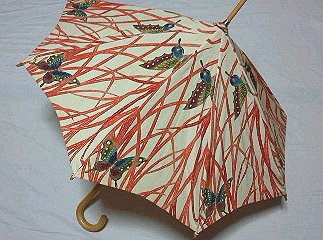 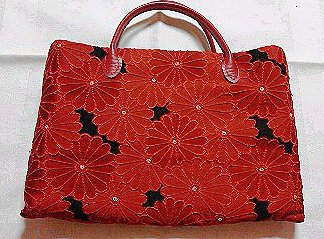
At that time, Mr. Seki said, "If you face the cloth carefully, the cloth will tell you what to do in the meantime."
In this guide, it was written that "I made the encounter between the sensibility and cloth cultivated in Ginza", but as the words implies, I think that a wonderful world of works will be unfolded.
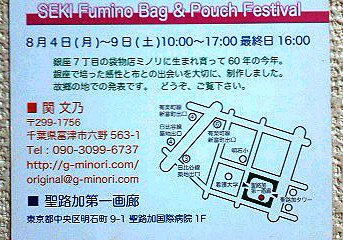
Seki Bunno Bag & Pouch Festival
From August 4 (Mon) to 9 (Sat)
From 10:00 to 17:00 (the last day ends at 16:00).
St. Luke's First Gallery
9-1, Akashicho, Chuo-ku
1F of St. Luke's International Hospital
[Kenken]
July 29, 2014 14:00
All you have to do is finish your business in Shimbashi on Saturday morning, and then prepare a souvenir for the banquet at night.
Take the Toei Asakusa Line, get off at Ningyocho, and go to the Suitengu intersection, which has a wider sky than usual due to temporary relocation to build a new main hall.
The recommendation in the house is Mr. Mihara-do (1-14-10 Nihonbashi Ningyocho) at the Suitengu intersection.
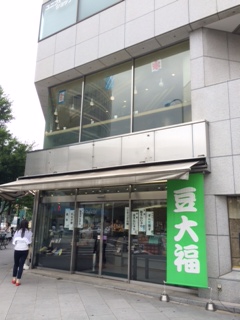 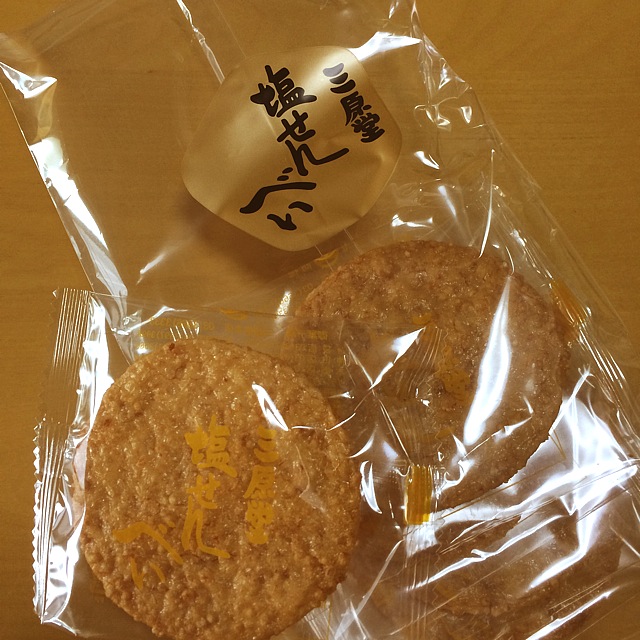
The salt rice cracker here has a crushing feeling of rice, and although it is thin, the chewy and the taste of soy sauce are solid, and I am delicious.
In addition to souvenirs, I bought a little for my family.
Well, after the souvenir, I'd like to buy lunch.
What I've always been worried about before was Ningyocho Imahan's side dish shop (1-14-5 Nihonbashi Ningyocho).
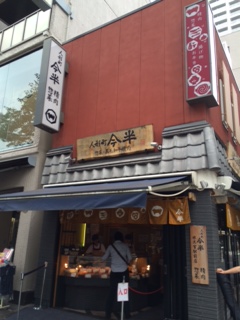
Here, I bought sukiyaki croquettes and homemade menchikatsu and went home.
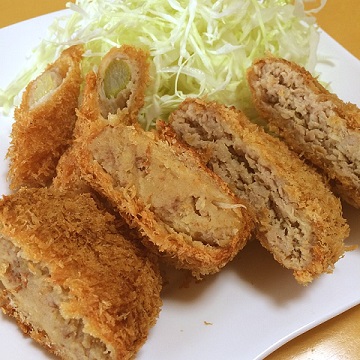
The sukiyaki croquette was thick and volumey, and the seasoning was undervalued, and it was a taste that made you feel the sukiyaki itself. I'm very satisfied!
I don't have any complaints. Even if it was a little cold, it was delicious enough!
The upper left of the photo is the asparagus meat roll. This was also good. Oh, I'm shredded cabbage in the middle.
I'm full. Thank you for your dinner.
|
Links
|




 Let's go through Plaza Harumi and look at Tokyo Bay. This is a spot where you can see Mount Fuji while walking.
Let's go through Plaza Harumi and look at Tokyo Bay. This is a spot where you can see Mount Fuji while walking.
 The first gallery next to the cafeteria on the first floor will be held from August 4 (Mon) to 9 (Sat).
The first gallery next to the cafeteria on the first floor will be held from August 4 (Mon) to 9 (Sat).




